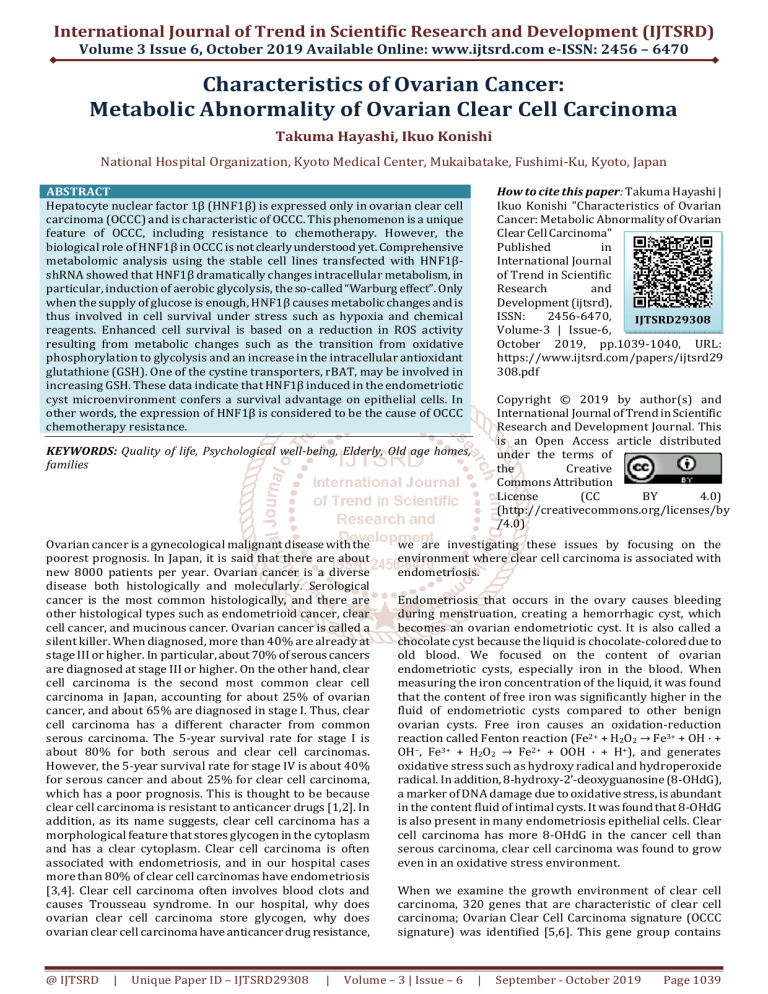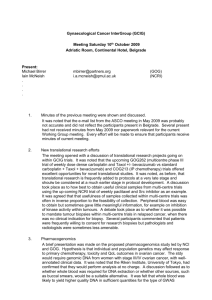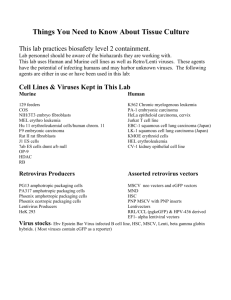
International Journal of Trend in Scientific Research and Development (IJTSRD)
Volume 3 Issue 6, October 2019 Available Online: www.ijtsrd.com e-ISSN: 2456 – 6470
Characteristics of Ovarian Cancer:
Metabolic Abnormality of Ovarian Clear Cell Carcinoma
Takuma Hayashi, Ikuo Konishi
National Hospital Organization, Kyoto Medical Center, Mukaibatake, Fushimi-Ku, Kyoto, Japan
How to cite this paper: Takuma Hayashi |
Ikuo Konishi "Characteristics of Ovarian
Cancer: Metabolic Abnormality of Ovarian
Clear Cell Carcinoma"
Published
in
International Journal
of Trend in Scientific
Research
and
Development (ijtsrd),
ISSN:
2456-6470,
IJTSRD29308
Volume-3 | Issue-6,
October 2019, pp.1039-1040, URL:
https://www.ijtsrd.com/papers/ijtsrd29
308.pdf
ABSTRACT
Hepatocyte nuclear factor 1β (HNF1β) is expressed only in ovarian clear cell
carcinoma (OCCC) and is characteristic of OCCC. This phenomenon is a unique
feature of OCCC, including resistance to chemotherapy. However, the
biological role of HNF1β in OCCC is not clearly understood yet. Comprehensive
metabolomic analysis using the stable cell lines transfected with HNF1βshRNA showed that HNF1β dramatically changes intracellular metabolism, in
particular, induction of aerobic glycolysis, the so-called “Warburg effect”. Only
when the supply of glucose is enough, HNF1β causes metabolic changes and is
thus involved in cell survival under stress such as hypoxia and chemical
reagents. Enhanced cell survival is based on a reduction in ROS activity
resulting from metabolic changes such as the transition from oxidative
phosphorylation to glycolysis and an increase in the intracellular antioxidant
glutathione (GSH). One of the cystine transporters, rBAT, may be involved in
increasing GSH. These data indicate that HNF1β induced in the endometriotic
cyst microenvironment confers a survival advantage on epithelial cells. In
other words, the expression of HNF1β is considered to be the cause of OCCC
chemotherapy resistance.
Copyright © 2019 by author(s) and
International Journal of Trend in Scientific
Research and Development Journal. This
is an Open Access article distributed
under the terms of
the
Creative
Commons Attribution
License
(CC
BY
4.0)
(http://creativecommons.org/licenses/by
/4.0)
KEYWORDS: Quality of life, Psychological well-being, Elderly, Old age homes,
families
Ovarian cancer is a gynecological malignant disease with the
poorest prognosis. In Japan, it is said that there are about
new 8000 patients per year. Ovarian cancer is a diverse
disease both histologically and molecularly. Serological
cancer is the most common histologically, and there are
other histological types such as endometrioid cancer, clear
cell cancer, and mucinous cancer. Ovarian cancer is called a
silent killer. When diagnosed, more than 40% are already at
stage III or higher. In particular, about 70% of serous cancers
are diagnosed at stage III or higher. On the other hand, clear
cell carcinoma is the second most common clear cell
carcinoma in Japan, accounting for about 25% of ovarian
cancer, and about 65% are diagnosed in stage I. Thus, clear
cell carcinoma has a different character from common
serous carcinoma. The 5-year survival rate for stage I is
about 80% for both serous and clear cell carcinomas.
However, the 5-year survival rate for stage IV is about 40%
for serous cancer and about 25% for clear cell carcinoma,
which has a poor prognosis. This is thought to be because
clear cell carcinoma is resistant to anticancer drugs [1,2]. In
addition, as its name suggests, clear cell carcinoma has a
morphological feature that stores glycogen in the cytoplasm
and has a clear cytoplasm. Clear cell carcinoma is often
associated with endometriosis, and in our hospital cases
more than 80% of clear cell carcinomas have endometriosis
[3,4]. Clear cell carcinoma often involves blood clots and
causes Trousseau syndrome. In our hospital, why does
ovarian clear cell carcinoma store glycogen, why does
ovarian clear cell carcinoma have anticancer drug resistance,
@ IJTSRD
|
Unique Paper ID – IJTSRD29308
|
we are investigating these issues by focusing on the
environment where clear cell carcinoma is associated with
endometriosis.
Endometriosis that occurs in the ovary causes bleeding
during menstruation, creating a hemorrhagic cyst, which
becomes an ovarian endometriotic cyst. It is also called a
chocolate cyst because the liquid is chocolate-colored due to
old blood. We focused on the content of ovarian
endometriotic cysts, especially iron in the blood. When
measuring the iron concentration of the liquid, it was found
that the content of free iron was significantly higher in the
fluid of endometriotic cysts compared to other benign
ovarian cysts. Free iron causes an oxidation-reduction
reaction called Fenton reaction (Fe2+ + H2O2 → Fe3+ + OH · +
OH−, Fe3+ + H2O2 → Fe2+ + OOH · + H+), and generates
oxidative stress such as hydroxy radical and hydroperoxide
radical. In addition, 8-hydroxy-2’-deoxyguanosine (8-OHdG),
a marker of DNA damage due to oxidative stress, is abundant
in the content fluid of intimal cysts. It was found that 8-OHdG
is also present in many endometriosis epithelial cells. Clear
cell carcinoma has more 8-OHdG in the cancer cell than
serous carcinoma, clear cell carcinoma was found to grow
even in an oxidative stress environment.
When we examine the growth environment of clear cell
carcinoma, 320 genes that are characteristic of clear cell
carcinoma; Ovarian Clear Cell Carcinoma signature (OCCC
signature) was identified [5,6]. This gene group contains
Volume – 3 | Issue – 6
|
September - October 2019
Page 1039
International Journal of Trend in Scientific Research and Development (IJTSRD) @ www.ijtsrd.com eISSN: 2456-6470
many oxidative stress-related genes, glycogen-related genes,
and coagulation-related genes, indicating that the nature of
clear cell carcinoma is reflected [5,6]. It was also found that a
gene network centered on hepatocyte nuclear factor-1-beta
(HNF1B), which is highly expressed in clear cell carcinoma,
has been constructed. Interestingly, it was found that iron
stress and oxidative stress induce the expression of the OCCC
signature gene. This physiological phenomenon suggests
that the nature of clear cell carcinoma is based on the
developmental environment. The transcription of HNF1B
was also regulated by DNA methylation.
This mutation in the HNF1B gene is known to cause
maturity-onset diabetes of the young, subtype 5 (MODY5)
[7,8]. Therefore, we examined the nature of clear cell
carcinoma by focusing on glucose metabolism. In the ovarian
clear cell carcinoma cell line, in which expression of HNF1B
was artificially suppressed, the expression of glucose
transporter type 1 (GLUT1) was suppressed and glucose
uptake was suppressed. This is known as the Warburg effect
and reflects the characteristic of cancer cells that anaerobic
glycolysis is enhanced even in an aerobic environment,
HNF1B also promotes the synthesis of glutathione, known as
an antioxidant, via related to b0,+ amino acid transporter
(rBAT), a cystine transporter. It has been found that the
reactive oxygen species in the cells are reduced to show
resistance to iron stress and anticancer drugs [9].
Unfortunately, there are no molecularly targeted drugs that
target HNF1B or rBAT. However, we focus on a molecule
called pyruvate dehydrogenase kinase isoform 2 (PDK2) that
controls the function of mitochondria in which the Warburg
effect and tricarboxylic acid (TCA) cycle work. The
experiments with mice have shown that controlling
mitochondrial function increases the sensitivity of
anticancer drugs. In the future, not only molecular targeted
drugs targeting cancer-related genes but also development
of therapeutic methods targeting metabolism are expected
as new cancer treatments.
Disclosure of potential conflicts of interest
The authors declare no potential conflicts of interest.
Acknowledgments
This study was supported in part by grants from the Japan
Ministry of Education, Culture, Science and Technology
(No.24592510,
No.15K1079,
No.17H01587
and
No.19K09840), The Foundation of Osaka Cancer Research,
The Ichiro Kanehara Foundation of the Promotion of Medical
Science and Medical Care, The Foundation for the Promotion
of Cancer Research, Kanzawa Medical Research Foundation,
Shinshu Medical Foundation, and Takeda Foundation for
Medical Science.
@ IJTSRD
|
Unique Paper ID – IJTSRD29308
|
Author Contributions
T.H. performed most of the experiments and coordinated the
project; T.H. conceived the study and wrote the manuscript.
I.K. gave information on clinical medicine and oversaw the
entire study.
References
[1] Eltabbakh GH, Mount SL, Beatty B, Simmons-Arnold L,
and Cooper K. (2006) Clinical and molecular
differences between clear cell and papillary serous
ovarian carcinoma. J Surg Oncol. 93, 379-86.
[2] Crotzer DR, Sun CC, Coleman RL, Wolf JK, Levenback
CF, and Gershenson DM. (2007) Lack of effective
systemic therapy for recurrent clear cell carcinoma of
the ovary. Gynecol Oncol. 105, 404-8.
[3] Mandai M, Yamaguchi K, Matsumura N, Baba T, and
Konishi I. (2009) Ovarian cancer in endometriosis:
molecular biology, pathology, and clinical management.
Int J Clin Oncol. 14, 383-91.
[4] Crotzer DR, Sun CC, Coleman RL, Wolf JK, Levenback
CF, and Gershenson DM. (2007) Lack of effective
systemic therapy for recurrent clear cell carcinoma of
the ovary. Gynecol Oncol. 105, 404-8.
[5] Amano Y, Mandai M, Yamaguchi K, Matsumura N,
Kharma B, Baba T, Abiko K, Hamanishi J, Yoshioka Y,
and Konishi I. (2015) Metabolic alterations caused by
HNF1β expression in ovarian clear cell carcinoma
contribute to cell survival. Oncotarget. 6(28), 2600217.
[6] Mandai M, Amano Y, Yamaguchi K, Matsumura N, Baba
T, and Konishi I. (2015) Ovarian clear cell carcinoma
meets metabolism; HNF-1β confers survival benefits
through the Warburg effect and ROS reduction.
Oncotarget. 6(31), 30704-14.
[7] Horikawa Y, Iwasaki N, Hara M, Furuta H, Hinokio Y,
Cockburn BN, Lindner T, Yamagata K, Ogata M,
Tomonaga O, Kuroki H, Kasahara T, Iwamoto Y, and
Bell GI. (1997) Mutation in hepatocyte nuclear factor-1
beta gene (TCF2) associated with MODY. Nat Genet. 17,
384-5.
[8] Fajans SS, Bell GI, and Polonsky KS. (2001) Molecular
mechanisms and clinical pathophysiology of maturityonset diabetes of the young. N Engl J Med. 345, 971-80.
[9] Kornfeld JW, Baitzel C, Könner AC, Nicholls HT, Vogt
MC, Herrmanns K, Scheja L, Haumaitre C, Wolf AM,
Knippschild U, Seibler J, Cereghini S, Heeren J, Stoffel M,
and
Brüning
JC.
(2013)
Obesity-induced
overexpression of miR-802 impairs glucose
metabolism through silencing of Hnf1b. Nature.
494(7435), 111-5.
Volume – 3 | Issue – 6
|
September - October 2019
Page 1040





![Anti-Chromogranin A antibody [LK2H10], prediluted ab53464](http://s2.studylib.net/store/data/013861580_1-6a125acf2ac6cf19437ef7829c6fe4ff-300x300.png)